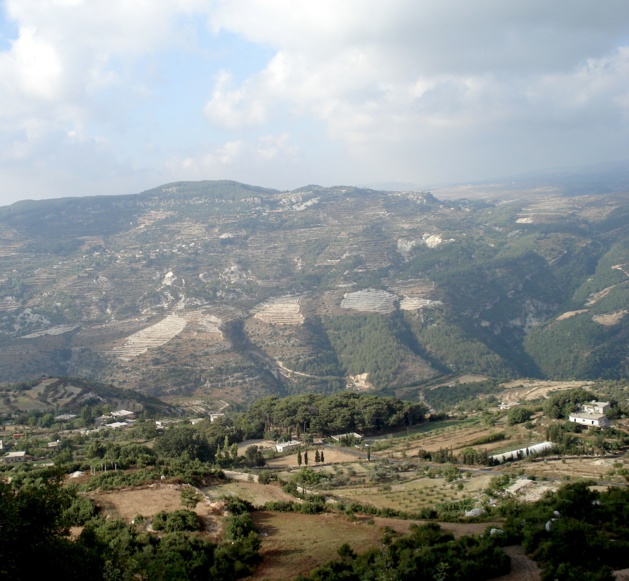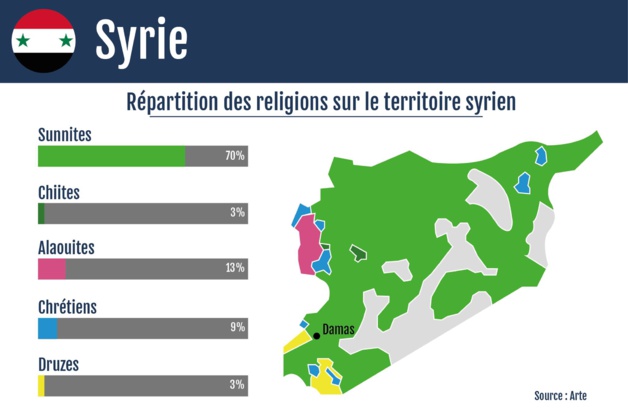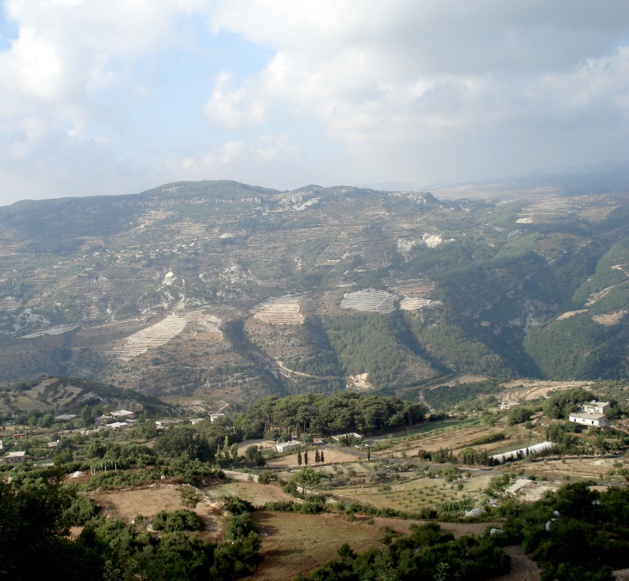
Credit : Bruno Paoli
The Alawi represent 10-12% of the Syrian population, about 2-2.5 million people, according to Bruno Paoli, founder of the French Institute for Middle Eastern studies. A number of Alawi live in northern Libya and in Turkey. The historic origin of this branch of Shi’ite Islam is not very well known, and dates back to the 9th century. After a period of expansion in the 10th century, these practitioners found refuge in the mountains on the western coasts of Syria, upon the arrival of the Mameluks—reconverting to Sun’ni Islam. Thus, Alawi is a religion, but today it is linked closely to kinship and to the community. Its practice as a religion is rather discreet. As such, some describe it as an esoteric and initiatory interpretation of the Qu’ran. Its adherents are likewise characterized by their “secular” traditions; indeed, their religious practices do not require mosques, the women do not wear veils, and alcohol is permitted.
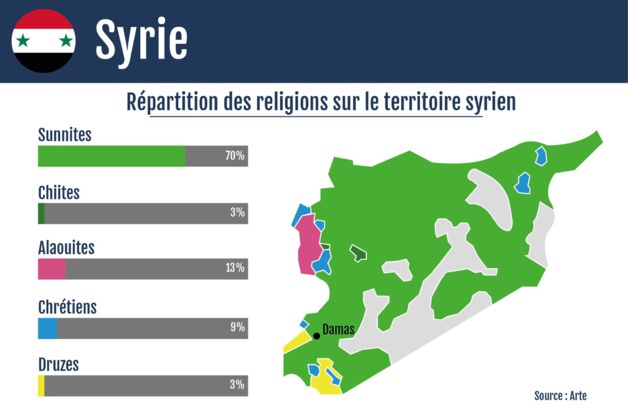
One must nevertheless remember that this “community” is not homogenous, and that the modes that have been used to categories the populations remain coarse to this day. However, these modes make a glaring mistake by generalizing the discussions and positions taken through a religious, communal and often ethnic belonging. They therefore consider Alawi to be in support of the Damas regime, while others are alarmed by this minority victim of Islamic jihadism.
Amalgamation, generalization and clichés
One of the most stigmatizing amalgamations resides in the association made in the media between the Assad regime and the “Alawi regime”. It is true that the Alawi are the majority in the government and in the Army. However, with the exception of the elite, an average officer is housed in the same military as his peers of other religions. Power is in reality more about family than religion. And in this case, the Assad understand very well that it is within their best interest to play upon religious confessions.
At first glance, it is rather a policy of assimilation that the Assad, father and son, have led in Syria. From the 1930s, the Ba’ath party has been gaining momentum as the defender of minorities against the Sunni majority; in many cases reflecting the attitude in the 1920s and ‘30s of France, which placed its protection upon the Alawi minority, more for political strategy than for solicitation. The Ba’ath party has allied itself with the troops since 1963. The rise to power of Hafez al-Assad will divide supporters between their nationalistic orientation, favoring the Arab union and hostility to Israel, and a more progressive camp focused on social struggles. The Ba’ath regime therefore advocated a secular façade on one side, while the other persistently stress a sense of community. Contradictory decisions have come out, like the construction of numerous mosques under Hafez al-Assad, in order to assure the remembrance of religious authorities.
In addition to this assimilation policy, a true “networking” of society has developed through the Alawi community, of the Assad family is a member. Formerly situated in the “mountain refuges”, the installation of Alawi in the cities coincided with the seizing of power by Hafez al-Assad in 1973. The placement of people close to Assad in the most important posts in government and in the army have allowed a closing of ranks. On another scale, the communal identification allows the reinforcement of the idea of a need to stand behind one’s leader. The perception of the current leadership as a “lesser evil” plays a role as well in this game of networking and surveillance. The Syrian population has thus had a tendency to associate the Alawi as the clan in power.
Fear as a tool in the regime
Since the uprisings in 2011, the propaganda of the Syrian regime puts the jihadist and Sunnite menace to the forefront. At the beginning of the revolts, the Syrians took to the street, all religions in conjunction. While some hoped that Assad would reform before the crisis worsened, a number of Alawi rallied at demonstrations. Then, slogans started appearing; they assimilated “Alawi” with “Assad”, and called for vengeance against his “supporters”. The sequence of events has thus caused many to withdraw, reflect, and attempt to withdraw again. Many surrender to the threat and renounce the demonstrations, but are seen as silent supporters. As is often the case in times of conflict, grievances are played on alliances; even as the ingrained belief that “the enemy of my enemy is my friend”, has often proved itself misleading as a term.
Assad plays upon these perceptions, describing the revolt against his regime as a “A radical Sunni revolt”. In this way he “confessionalizes” the conflict, and by extension deprives it of its political, social and economic reasons. Communication by the regime rides the waves of media coverage of Islamic State’s progression, and ceaselessly reminding its people that the State will leave chaos in its wake. The fashion in which the State seized Palmyra, and the subsequent response of the international community is a glaring example.
“Marketing” the war
These perceptions and beliefs that are in truth motivated more by fear than by naivety can produce tangible risks. Several incidents have already been reported between denominations. In May 2012, 108 people were killed in the village of Houla. The attackers claimed to be working for the regime. However, some time later, documents and testimonies describing members of the Free Syrian Army who would have come to massacre families that had converted to Alawi and Shi’ism, as well as those who did not join the rebellion.
The region includes many Alawite villages as the site of several clashes between the rebellious forces and those belonging to the regime, who provide Alawi and Shi’ites with arms. Less than two weeks after the incident in Houla, a killing in al-Koubeir was attributed to loyalists and militias originating from neighboring Alawi villages. While it is difficult to specify a perpetrator, one thing is clear: The ability to mobilize for these massacres is of great importance, both for loyalist militias, and for the rebellion. People are central in the instrumentation of political ambitions, they take part in these conflicts, and are therefore locked in a deadly and vicious cycle.
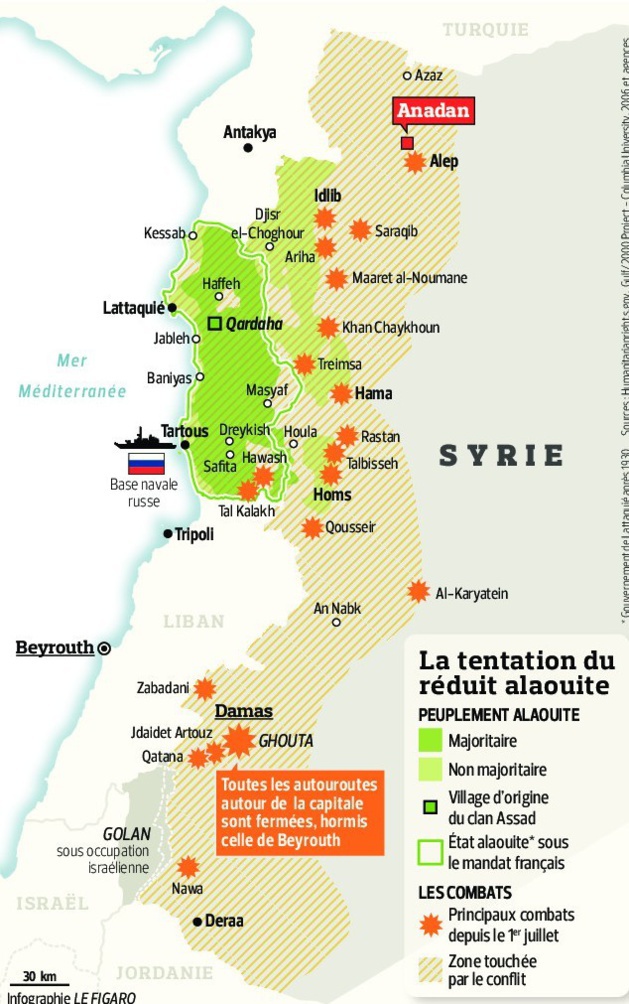
Though these massacres affect several communities and causes them to respond to one another, the International Crisis Group (ICG) fears an “ethnic cleansing” that will affect the Alawi, putting in perspective the risk of an increase in the event of the fall of the regime, which only pretends to protect them. This issue has become a central topic of the conflict.
An Alawi “State” for the regime?
Strategically, a possible solution would be for the regime to bide its time and wait for a better moment. The proposal to create a mini-State on the west coast of Syria, with access to the sea several military bases, is not new and has been contemplated for some time. Assad’s father has prepared for this region to be as livable and as viable as possible. As such, this “mini-State” would have optimum lad for agriculture, a Latakia airport, a port in Tartous (which would result in constant support from Russia), and the oil port in Baniyas.
The Alawi population in this region his closed their ranks since the beginning of the conflict, and solidarity between communities would mean greater strength for the mini-State. However, this does not account for the state of relations between inhabitant of the mini-State and inhabitants of “Old Syria”.
Power in Syria is proportionate to political strategy rather than religion, and the rebellion is likewise more motived by individual context rather than communal solidarity. If leaders were to implement the “divide and rule” plan, the plan is ineffective without those who are to be divided: the population, as well as public opinion.














